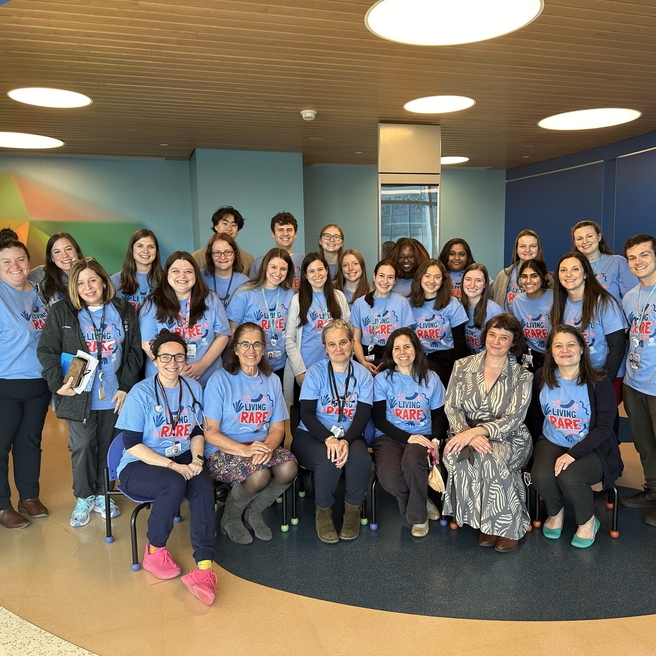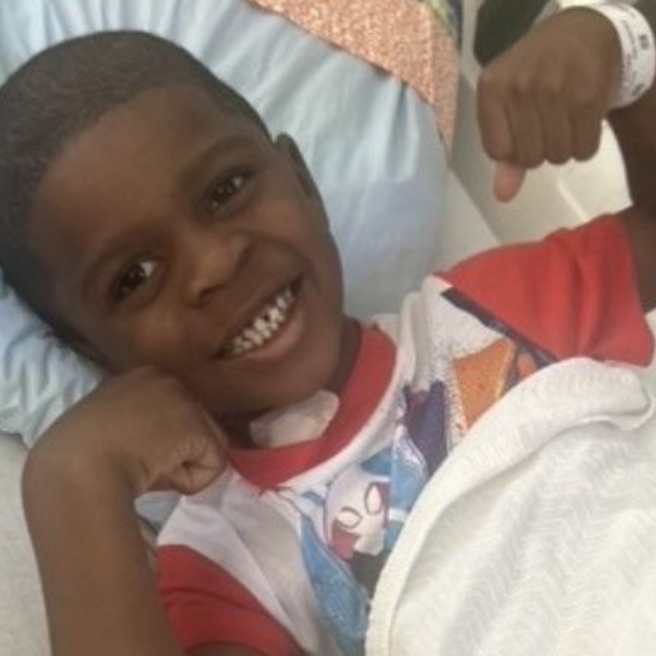What is leukodystrophy?
Leukodystrophies are a group of rare, genetic disorders that affect the white matter of the brain. The word leukodystrophy comes from leuko, which means white, and dystrophy, which means imperfect growth. Leukodystrophies are characterized by this abnormal growth of white matter in the brain. Specifically, these diseases damage the brain’s myelin sheath, which acts as an insulator around nerve fibers in the brain and spinal cord.
Damage to the myelin sheath slows down or blocks messages between the brain and the rest of the body and can cause problems with:
- Movement
- Speaking
- Vision
- Hearing
- Mental and physical development
Most leukodystrophies are neuro-degenerative. This means that in time, if left untreated, the diseases progress, causing more destruction to the white matter and worsening symptoms.
Types of leukodystrophy
There are many different types of leukodystrophies, with new ones being classified each year. Currently there are about 30 classified leukodystrophies and many additional leukoencephalopathies, but many more are still unclassified. Research is ongoing to try to lower the number of unclassified diseases.
Some of the more common leukodystrophies that are classified include:
- Aicardi-Goutières syndrome
- Adrenoleukodystrophy (ALD)
- Alexander disease
- Canavan disease
- Cerebral adrenoleukodystrophy
- Cerebrotendinous xanthomatosis
- Krabbé disease
- Metachromatic leukodystrophy (MLD)
- Niemann-Pick disease
- Pelizaeus-Merzbacher disease (PMD)
- Vanishing White Matter (also known as childhood ataxia with central nervous system hypomyelination)
Signs and symptoms
Symptoms of leukodystrophies vary by disease, progression and the areas of the brain affected. Some common symptoms include:
- Developmental regression (loss of skills previously achieved)
- Trouble with motor skills such as new onset problems with walking
- Seizures
- Cognitive decline
As the disease progresses, symptoms can include:
- Abnormal body and muscle tone
- Abnormal movements
- Increased difficulty or loss of ability to walk
- Trouble with speech
- Difficulty with eating
- Decline in vision and/or hearing
- Decline in mental and physical development
Specific symptoms will vary according to the type of leukodystrophy your child has and how much the disease has progressed. Also, each leukodystrophy can affect a child in a unique way. You can work with your care team to discuss what specific concerns you have regarding your child.
Causes
Most leukodystrophies are genetic. Many are inherited (passed down from generation to generation) but some can be sporadic mutations, meaning that a person did not inherit the disease from their parents.
Symptoms usually appear during infancy or childhood, but some individuals do not show symptoms until adolescence or adulthood. Early signs can be difficult to recognize as a leukodystrophy because children initially appear healthy overall, but over time symptoms gradually worsen and disease becomes more apparent.
Testing and diagnosis
Some leukodystrophies such as Krabbé disease, ALD and MLD are included in newborn screening panels, but newborn testing varies by state. Some states have passed the law but are not actively testing for the disease yet.
Contact your child’s pediatrician to get a copy of your child’s newborn screening results. They should also be able to tell you what was being actively tested for as part of newborn screening in your state at the time your child was born.
Once your child presents with symptoms concerning for a leukodystrophy, your team may recommend evaluation with tests such as MRI, blood work, genetic tests, urine tests, and neuropsychological screenings.
- An MRI (magnetic resonance imaging) exam uses a magnetic field and pulses of radio wave energy to create very detailed pictures of the brain, spinal cord or other organs. These pictures can identify many different types of abnormalities in the brain and help in the diagnosis of your child’s particular form of leukodystrophy. Unlike x-rays and CT scans, MRI does not expose your child to radiation, but may require sedation in young children to help them stay still and comfortable. Your care team can discuss this further with you.
- Genetic tests analyze our DNA to look for changes in genes that may be causing your child’s leukodystrophy. Most genetic testing is done with a blood sample. In some cases, a specific leukodystrophy may be suspected and targeted testing can be done to look for that condition. In other cases, your child’s symptoms may not fit one particular pattern, so more comprehensive genetic testing may be considered. This may include testing for many genes simultaneously. Your care team will discuss with you the most appropriate testing strategy for your child. It can take weeks to months for results.
- Neuropsychological testing is a series of tests to assess cognitive function. This type of testing helps your child’s medical team find out how the leukodystrophy is affecting your child’s ability to reason, concentrate, solve problems and remember.
Leukodystrophy Treatment at CHOP
For children living with the complex challenges of leukodystrophy, Children’s Hospital of Philadelphia provides state-of-the-art care through our Leukodystrophy Center of Excellence. Your child has access to doctors and clinicians who are experienced in caring for individuals with leukodystrophies, and are actively involved in ongoing research to find new treatments.
One of the goals of our Leukodystrophy Center is to identify patients early in the disease course in order to determine if they would benefit from a bone marrow or stem cell transplant, or gene therapy. Bone marrow transplants (BMT) are considered standard of care for some leukodystrophies such as ALD, but the disease needs to be diagnosed early for your child to be eligible for the procedure. BMT cannot reverse any changes that already occurred from the disease, but can help slow future disease progression and minimize neurological decline. If your child is eligible for a bone marrow transplant, we work in collaboration with our world class Blood and Marrow Transplant Program to explore all available options.
Researchers continue to evaluate new treatment options, including ongoing studies of bone marrow and stem cell transplantation, enzyme replacement, and gene therapy. We also collaborate with other institutions and will refer your child to any actively enrolling trial if they are eligible. To stay up to date on current clinical trials for your condition of interest, please visit www.clinicaltrials.gov.
While most leukodystrophies do not currently have cures or treatments , many of the symptoms can be managed to support your child in achieving the highest quality of life possible.
Managing symptoms
Treatment for most leukodystrophies involves treating symptoms, preventative care and coordination of care. Your child may benefit from medication for management of spasticity or seizures, physical, occupational and speech therapy, nursing support in the home or adaptive school curriculum. Our team is here to help navigate you through these processes.
Some of the many ways we can help you and your child include:
- Prescribing medications for spasticity, such as baclofen
- Answering questions about G-tubes
- Monitoring for safe oral feeding
- Helping obtain equipment for use in the home
- Maximizing therapy
- Supporting your family along this journey
At CHOP’s Leukodystrophy Center, your child’s team of providers includes experts in neurology, , complex care pediatrics, genetics, rehabilitative medicine, endocrinology, physical therapy, occupational therapy, speech therapy, and nutrition, with additional nursing and social work support. We also work closely with the Justin Michael Ingerman Center for Palliative Care team, who offer additional support to families in the Leukodystrophy Center. The Center for Palliative Care can help to advocate for your child, improving quality of life for your child and family, helping to manage symptoms that cause discomfort, and providing emotional, social, and spiritual support.

About your child’s visit
Find information about scheduling appointments with CHOP’s Leukodystrophy Center and what to expect during your first visit.
Research
CHOP’s Leukodystrophy Center is actively studying disease progression and outcomes of patients with leukodystrophies such as Alexander disease in order to better understand the course of these diseases and identify new treatment options.
Learn more about our current clinical research.
Outlook
The prognosis for leukodystrophies varies according to the specific type of leukodystrophy. Your child’s care team will discuss treatment options, research availability, and long term prognosis with you as it relates specifically to your child.
Follow-up care
Your child will be followed on a regular basis for monitoring and management. Specific follow up will be determined by your child’s care team. Most patients are seen in our Leukodystrophy Center every 6-12 months but have more frequent visits with their neurologist for ongoing care in the interim.
If you are out of state or travel a far distance from CHOP and have a primary team closer to home, we can also support you by seeing your child every 6-12 months and working with your local team to provide a care plan to help navigate your child’s care between visits.
Resources to help
Leukodystrophy Resources
Leukodystrophy Center Resources
We have created resources to help you find answers to your questions and feel confident with the care you are providing your child.
Reviewed by Erin O'Connor Prange, MSN, CRNP, Amy Waldman, MD


